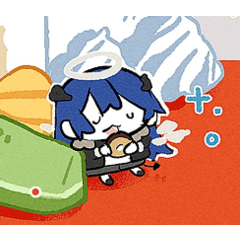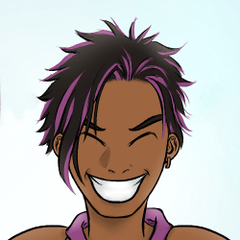Replicating Custom Shape Effect in Clip Studio Paint
Intro
One of the most common trick used by Digital Artists, especially in environmental art; is the Photoshop-only feature "Custom Shapes." However, while it's not completely perfect. Clip Studio can actually replicate this feature in its own way, and let you create your own custom shapes or port them from custom shapes you already have.
How?
In this tutorial we will look at what customs shapes are, how they're used, and how to make your own or use ones you already have from photoshop.
Note: While this will replicate the "effect" of custom shapes in art. It will can never be true custom shape in having paths as CSP does not do paths yet. This is just replicating the effect for your digital painting.
1. What are Custom Shapes?
Put simply. Custom Shapes are Vectors. This means they can be resized consistently, moved, warped, and skewed, and never lose quality.They are made of curves and lines geometrically, instead of pixels like raster images. If you use Clip Studio, chances are you've messed with vectors when using the vector line-tool. Custom Shapes are like that. But more.
Where CSP has vector lines. Custom Shapes are vector shapes, filled vector lines that never lose quality. In PS, Custom Shapes are used in a shape-layer that fills the selection paths. You can have as many shapes as you want, including an entire canvas full. Like so:
As can be seen. Custom Shapes are powerful. This will be furthered on when we talk about what they're used for. However, this is in Photoshop.
For CSP, we've seen them used ... somewhat. Such as under "Figures" the Streamlines and Saturated Lines. Vector effects to create speed-lines and the like.
For Custom Shapes however. We can't fully replicate the Vector effect PS has even when converting to a vector layer, as it will lose some of the detail But, we can replicate them their use, and the effect they give.
2. What are Custom Shapes used for?
While Custom Shapes can be thought of maybe an arrow, a stop sign, those heart symbols. The usual shapes you see in graphics programs. That's not all they are. They can be so much more. From the most detailed rock, the most simplest outline of a bush. Custom Shapes are used to pick up the pattern of an image from photos to the extent that you want, and replicate that to be used in your files when you need them.
Many Digital Artists, especially Environmental Artists are known to use these frequently in either their drafting, or even their complete work. But, just as one can over-use Photosbashing, textures, and brushes. Custom Shapes can also look tacky if overused. That's why you want to know what you're going for before you use them.
While my art is not the best, these are some samples of the power of Custom Shapes.
As a draft:
Blending them into art:
If you need more examples, google "custom shape environmental art".
3. Replicating Custom Shapes on CSP - Making Your Own
So how do we make Custom Shapes in Clip Studio?
First we open a photo that we either took ourselves or we have permission to use.
For mine, I'm choosing this photo I took out the school library window. We're going to focus on grabbing the back building.
Now.. we can either just use the magic wand and eraser and mask out everything we want. Or we can go by color as well. Or use both.
First thing is first. Let's crop.
Seeing as I just want the back building. I don't want any of the above or below. So I use the select tool, select the part of the image I do want, and crop.
There. Now we have this, this is easier to work with.
So first the wand:
Select the magic wand and just start clicking the sky, the trees, and everything around the building.
If you find it taking too long and a color is very different than others you're selecting. Pull up Color Gamut and eye-drop the color you want to select more of.
Bump it down to 10 and start selecting and cutting, using Shift + click to select more than one thing.
Eventually, you want the full cutout.
I'm lazy, so I personally am just going to go with this for my shape and keep the satellite and back building.
Now comes the next part. We de-saturate the image. Pull up your saturation and crank it all the way to the left. Like-so.
Now open Tone Curves or Levels and play with it until you get a nice contrast. We want black and white, but with details.
For me, this should suffice.
Now select all the black.
Cut it and paste it to its own layer.
Now hide the layer without black and we have our shape we're going to register.
Now go to Edit - Register Material - Image.
Set these settings.
Choose a folder under materials.
Tag it what you want to find it.
Make sure to select "Scale up/down" and set to "Adjust according to destination."
Select "Use for brush tip shape."
You should now have your shape under the folder you chose in materials.
If we click and drag it to the canvas, we get options to resize normal, move, rotate, or resize to perspective.
To change the color just use the screentones option.
This effectively lets you make and use a shape like Photoshop.
If you want to vector it you can always convert layer, however, it loses some of the detail.
4, Replicating Custom Shapes on CSP - Using Ones From Photoshop
How do we port Photoshop Shapes? Simple. Open a PS document. Select the custom shape you want. (I'm using this guys free shapes here https://gumroad.com/l/Bxta ) and make it as big as you can without lagging on a transparent document. Then save as .png.
Now open it in Clip and follow the directions from creating your own.
You now have a Photoshop Custom Shape in CSP.
That concludes the tutorial. I hope this helps for Digital Artists that needed a way to do shapes in CSP or any new artists that didn't know the use you could use Custom Shapes for.























コメント